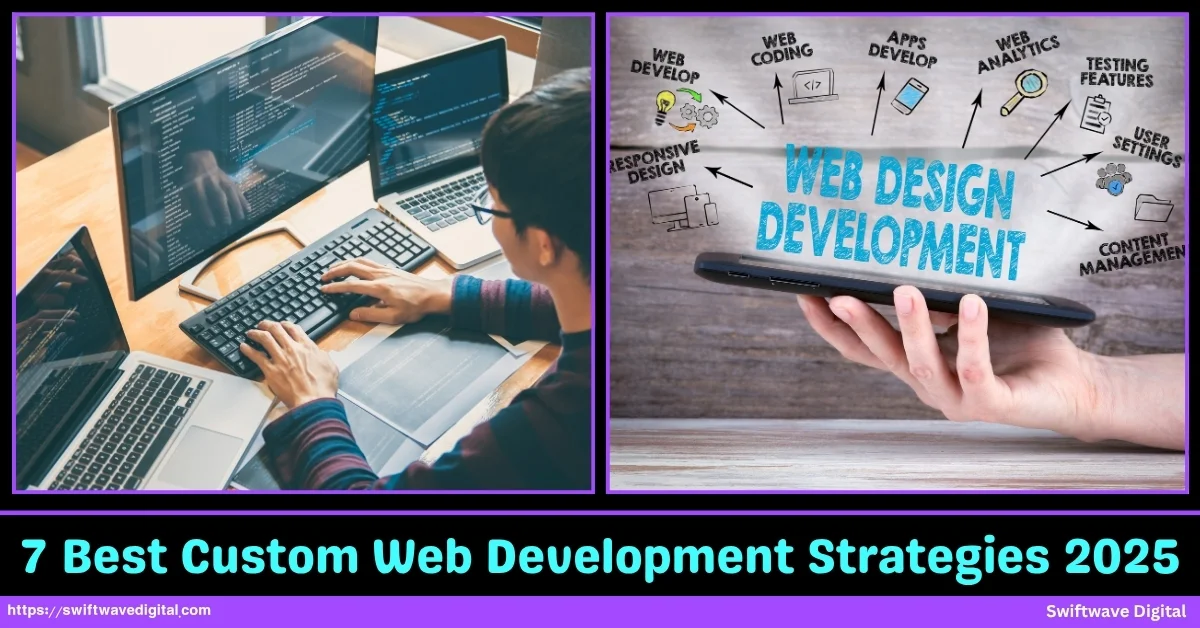Custom Web Development is no longer just about creating a website it’s about building a digital foundation that drives business growth, adapts to new technologies, and delivers measurable performance.
In 2025, the web ecosystem has evolved dramatically. Businesses that once relied on pre-built templates or off-the-shelf CMS solutions are realizing that they can’t compete in a fast-moving digital market without tailored systems designed around their own workflows, data, and customer journeys.
Custom development offers flexibility, scalability, and precise control allowing companies to align their websites and applications with specific goals, rather than forcing their goals to fit within generic limitations.
As technologies like AI-driven personalization, modular architectures, and API-first systems become the standard, businesses need to rethink how their web platforms are structured, secured, and optimized.
The difference between a standard website and a high-performing digital platform often comes down to strategic planning and execution and having the Right Development Partner can quietly turn that difference into your biggest competitive advantage
7 Best Custom Web Development Strategies 2025
In this guide, we will explain the 7 best custom web development strategies you should implement in 2025 to stay ahead of the curve and build a future-ready web presence.

Strategy 1: Modular / Component-Driven Architecture
Modern websites and web applications cannot survive as single, monolithic systems anymore. A modular or component-driven architecture is essential in 2025 because it allows developers to divide large systems into independent, reusable parts.
This means each module or component can be built, tested, and deployed without disrupting the entire project.
For example, the user authentication system, product catalog, and payment gateway can exist as separate components that communicate through defined interfaces.
This approach makes maintenance much easier. When you need to fix or improve one module, you don’t risk breaking the rest of the site. It also helps multiple teams work simultaneously on different parts of the system, which reduces development time.
Technologies like React, Vue, Angular, and Svelte are built on this principle, allowing developers to reuse UI components across projects.
The same concept applies to the backend, where microservices divide the logic into smaller services that handle specific tasks such as email notifications, billing, or analytics.
To implement modular architecture effectively, developers should start by mapping out all major functions of the website. Each function should then be assigned as a separate component or service.
This structure should include clear API boundaries, version control, and standardized communication protocols. Proper documentation is key to ensuring that future developers can integrate or replace components without rewriting large sections of code.
Strategy 2: API-first / Headless Architecture
In 2025, an API-first approach is the backbone of modern web systems. The traditional model of building a backend that directly serves HTML to the frontend is too rigid for today’s multi-device world.
Websites now need to serve data to mobile apps, IoT devices, dashboards, and even third-party integrations. An API-first or headless architecture solves this by separating the content layer from the presentation layer.
In an API-first setup, developers build the backend as a collection of APIs that deliver data in formats like JSON or GraphQL.
The frontend then consumes this data through API calls, giving developers full freedom to design user interfaces in whatever framework they prefer.
This makes it easy to update the frontend without touching the backend and vice versa. It also allows future expansion—if your business decides to launch a mobile app or integrate with another platform, you already have a ready-to-use data source.
Adopting API-first architecture requires careful planning. Every data endpoint must be clearly defined with versioning to avoid conflicts. Security protocols such as token-based authentication (JWT or OAuth) must be implemented to control access.
Developers should also use caching and rate limiting to manage performance and prevent abuse. The end result is a more flexible, scalable, and integration-friendly system that supports growth and innovation.
Strategy 3: Performance-First / Core Web Vitals Focus
Performance is no longer optional—it directly affects user experience, search ranking, and conversion rates. Google’s Core Web Vitals (LCP, FID, and CLS) are now key SEO metrics, meaning a fast and stable website can outperform competitors even with similar content.
Users expect a site to load in under 3 seconds; beyond that, bounce rates increase dramatically.
A performance-first mindset should be embedded into every stage of web development. It starts with efficient coding—minimizing heavy libraries, lazy loading non-critical resources, and optimizing server responses.
Using CDNs (Content Delivery Networks) to serve static assets close to users significantly reduces latency. Modern frameworks also support tree-shaking and code-splitting, allowing only the necessary code to load per page.
Database performance must also be addressed. Indexing, query optimization, and caching layers such as Redis or Varnish can improve response times drastically and if that sounds complex — that’s where a Performance-Focused Team makes all the difference
Developers should continuously measure performance using tools like Google Lighthouse or WebPageTest. Continuous monitoring ensures that new features don’t degrade the user experience.
n short, fast-loading, responsive, and stable sites don’t just please users—they build trust, improve SEO, and boost overall ROI.
Strategy 4: DevSecOps / Security-Integrated Pipeline
Security threats grow more sophisticated each year, and in 2025, web development without integrated security is simply irresponsible.
The DevSecOps approach merges development, operations, and security into one continuous workflow. This means security isn’t added at the end—it’s baked in from the start.
Developers should use automated tools to scan for vulnerabilities during coding and before deployment. Dependency checkers can flag outdated libraries that may contain known security flaws.
All sensitive data must be encrypted, and access control policies should follow the principle of least privilege. Additionally, every environment development, staging, and production should have the same security standards to avoid weak spots.
Security testing should be automated and ongoing. This includes penetration testing, static code analysis, and real-time monitoring for unusual activity.
Integrating these checks into CI/CD pipelines ensures that each deployment passes security validation automatically. SSL certificates, secure headers, and Content Security Policies (CSP) should be standard across all projects.
By making security part of the workflow rather than a final checklist, developers reduce risk, improve compliance, and protect both their users and reputation.
Strategy 5: AI-Assisted Development & Smart Personalization
Artificial Intelligence has become a fundamental tool in both development processes and user experience design. In 2025, AI-assisted development saves time, reduces human error, and helps teams build smarter systems.
Developers use AI-based tools for code completion, automated testing, and bug detection. These tools learn from vast codebases, providing intelligent suggestions that improve productivity and maintain cleaner code structures.
Beyond the development process, AI also enhances how websites interact with users. Smart personalization allows a site to adapt its content, recommendations, and interface based on user behavior.
This leads to better engagement and higher conversion rates. AI-driven search engines, chatbots, and recommendation systems analyze data in real time to deliver relevant experiences to each user.
Implementing AI should start with small, high-impact areas. For example, a recommendation module for eCommerce or an AI-powered chatbot for support both simple ways to see tangible results fast — especially with Expert Integration. Developers should also be mindful of data privacy and transparency.
AI decisions must be explainable, and personal data should comply with local regulations like GDPR or PDPA. The right integration of AI can make a website not only efficient but also more intuitive and responsive to users.
Strategy 6: Progressive Enhancement & Resilience
A robust web strategy ensures accessibility and reliability for every user, regardless of their device or internet speed.
Progressive enhancement focuses on building a basic, functional version of the website first, then layering advanced features for browsers and devices that support them.
This ensures everyone can use the website, even under poor network conditions or outdated browsers.
The first step in progressive enhancement is to design the site’s core structure with clean HTML and minimal dependencies. CSS and JavaScript should enhance the experience rather than define it.
For example, critical information and actions should be available even if JavaScript fails to load. This is particularly important for essential web services like eCommerce checkouts or contact forms.
Service workers can then be added to provide offline capabilities and faster caching. Developers should use feature detection instead of browser sniffing, ensuring that enhancements load only when supported.
This approach not only improves accessibility but also enhances SEO, since search engines can easily crawl the core content.
Progressive enhancement builds resilience, making your website functional under all conditions, which ultimately leads to higher reliability and user satisfaction.
Strategy 7: Green & Sustainable Web Development
Sustainability has become a growing concern in digital infrastructure. In 2025, businesses are increasingly aware of the environmental footprint caused by large websites, heavy scripts, and inefficient hosting.
Green web development focuses on reducing energy consumption, optimizing resources, and using eco-friendly technologies.
Developers can start by minimizing the size of websites compressing images, optimizing media, and removing unnecessary scripts. The smaller the data transferred, the less energy consumed by servers and devices.
Choosing green hosting providers powered by renewable energy can also make a meaningful impact. Reducing server requests, caching frequently accessed data, and using static site generation for content-heavy pages can cut down resource usage significantly.
A sustainable website is not only environmentally responsible but also technically efficient. Lean websites load faster, cost less to maintain, and deliver smoother experiences to users.
Building with sustainability in mind also sends a positive message to customers who value eco-conscious brands. Developers should track performance metrics like page size and server load as part of their sustainability audits to ensure they continuously improve efficiency.
Implementation Roadmap & Priorities
Adopting these seven strategies requires planning and consistency, not overnight changes. The first step is to audit your current web system. Identify where your site stands in terms of performance, modularity, and security.
List weaknesses such as slow loading times, outdated frameworks, or lack of API integration.
Next, prioritize the quick wins small improvements that bring immediate results, such as performance optimization and security upgrades. In parallel, plan long-term shifts like migrating to modular architecture or implementing API-first systems.
These transformations can happen gradually through the “strangler pattern,” where old components are replaced with modern modules over time.
Once your foundation is stable, integrate AI tools and personalization features to enhance automation and user experience.
Build your deployment process around DevSecOps principles to ensure every new update is tested, secure, and optimized before going live. Finally, adopt sustainable practices monitor site energy usage, switch to green hosting, and maintain efficiency with regular audits.
Continuous monitoring is key. Set measurable KPIs for speed, security, and user engagement. Use analytics and automated testing tools to ensure your web systems remain healthy as they grow.
Technology will keep evolving, but by following these seven strategies, your web presence will stay scalable, secure, and future-ready.
Conclusion
In 2025, custom web development is no longer just a technical process it’s a strategic advantage. Businesses that invest in structured, scalable, and intelligent web solutions are the ones staying ahead in user experience, visibility, and long-term growth.
The key lies in adopting practical strategies that blend flexibility, speed, security, and sustainability.
From modular and API-first architectures that simplify scaling, to performance optimization that directly impacts conversions, each strategy serves a distinct role in building a resilient online ecosystem.
Integrating DevSecOps keeps your platform secure from day one, while AI-driven personalization ensures every user interaction adds value.
Meanwhile, progressive enhancement maintains accessibility across devices, and sustainable coding practices future-proof your brand both technically and ethically.
The digital landscape is changing faster than ever, but with a data-backed approach and consistent innovation, your website can evolve with it not struggle against it.
Implementing these seven strategies will help your business create a web presence that performs, protects, and prospers well into the future.



